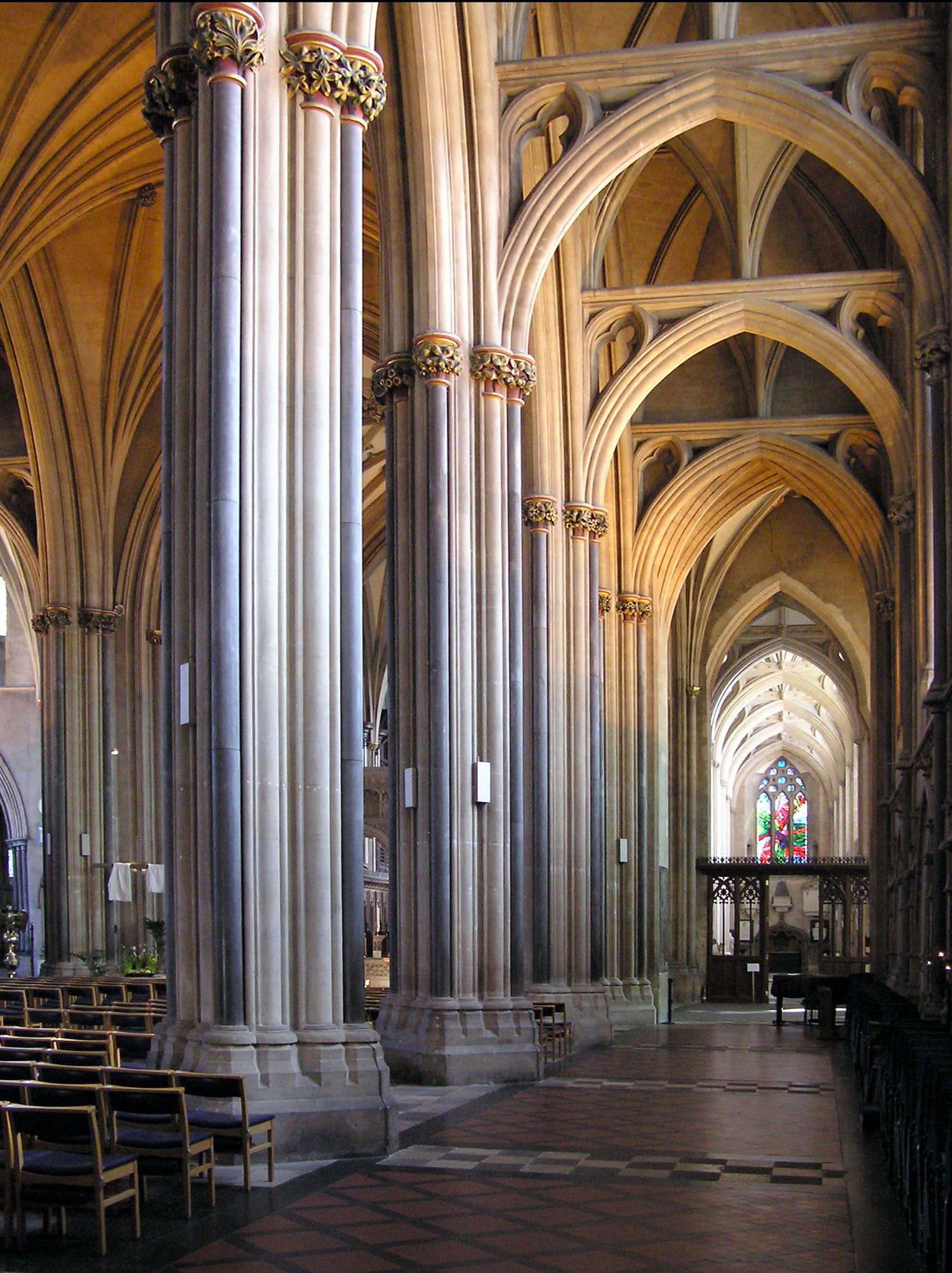
Aisle
An aisle is a linear space for walking with rows of non-walking spaces on both sides. Aisles with seating on both sides can be seen in airplanes, in buildings such as churches, cathedrals, synagogues, meeting halls, parliaments, courtrooms, theatres, and in long passenger vehicles. An aisle floor may be level or, as in theatres, sloping upward from a stage.
For other uses, see Aisle (disambiguation).
Aisles also cross through shops, where they have shelving on either side; warehouses, flanked by storage pallets; and factories, where they separate different work areas. In health clubs, exercise equipment is normally arranged along aisles.
They are distinguished from corridors, hallways, walkways, footpaths, pavements (American English sidewalks), trails, paths and open areas of buildings: aisles lie between other open or seating areas, which are all enclosed within a structure. Spaces between buildings are not considered aisles, regardless of their size.
The word is related to French aile (wing).
Architecture[edit]
In architecture, an aisle is more specifically the wing of a house, or a lateral division of a large building. The earliest examples of aisles date back to the Roman times and can be found in the Basilica Ulpia (basilica of Trajan), which had double aisles on either side of its central area. The church of St. Peter's in Rome has the same number.[1]
In church architecture, an aisle (also known as an yle or alley) is more specifically a passageway to either side of the nave that is separated from the nave by colonnades or arcades, a row of pillars or columns. Occasionally aisles stop at the transepts, but often aisles can be continued around the apse. Aisles are thus categorized as nave-aisles, transept-aisles or choir-aisles. A semi-circular choir with aisles continued around it, providing access to a series of chapels, is a chevet.[1]
In Gothic architecture, the aisles' roofs are lower than that of the nave, allowing light to enter through clerestory windows. In Romanesque architecture, however, the roofs are at roughly equal heights, with those of the aisle being only slightly lower than that of the nave. In Germany, churches where the roofs of the aisles and nave are the same height, such as St. Stephen's, Vienna, the Wiesenkirche at Soest, St. Martin's, Landshut, and the Frauenkirche (Church of Our Lady) in Munich are known as Hallenkirchen.[1]
When discussing overall design, architectural historians include the centrally-positioned nave in the number of aisles. Thus the original St Peter's Basilica in Rome, Milan Cathedral, Amiens Cathedral, Notre Dame de Paris and Alexander Nevsky Cathedral in Sofia[2] are all described as having five aisles, meaning they have two side aisles either side of the nave. Antwerp Cathedral even has seven aisles (three at either side of the central nave). In the United Kingdom, cathedrals generally only have one aisle on each side, with Chichester Cathedral, Elgin Cathedral and St Mary Magdalene, Taunton being the only three exceptions.
Libraries are commonly divided into several areas:
The spaces between rows of book shelves in the "stacks" area are called aisles and desks in the reading area are frequently arranged in rows with aisles.
On vehicles, the aisle is more specifically a passageway for passengers to move along within the vehicle.
Safety and regulatory considerations[edit]
National and local government regulations require a minimum width for aisles in various building types. Regulatory agencies frequently inspect buildings, vehicles, etc., to enforce regulations requiring that aisles not be restricted. Inspectors have imposed fines for blocking or restricting passage when boxes or folding chairs are stored in aisles, for example. Insurance companies frequently have safety inspectors to examine the premises, both to determine whether insureds are complying with the insurer's requirements for coverage and to look for any practices that could lead to injury or property damage, including restricting passage in aisles.
The Americans with Disabilities Act sets certain standards for building access and other design considerations in all new construction and major renovations in the U.S.[4] An architectural barrier is any feature that makes access or use of a building difficult, unreasonably dangerous or impossible. This can include aisles that are too narrow for easy access by a wheelchair.[5] Often, the only way to get from a row of chairs, shelves, workstations, etc., to an exit is by an aisle. Historically, many deaths and serious injuries have occurred due to fire, inhalation of smoke or noxious fumes, etc., because blocked or partially blocked aisles prevented persons from promptly leaving a dangerous area.
Regulations applicable to public carriers transporting passengers often require aisles to be completely clear in vehicles, such as airlines, buses and trains. Many insurance companies have requirements regarding minimum aisle width, unrestricted aisles and easy access to exits, and will refuse to insure companies that do not meet their requirements or will increase the premiums on companies that frequently violate the requirements.





